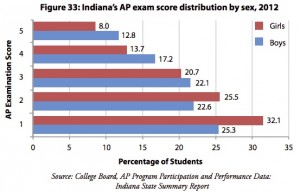Despite Strong ISTEP+ Scores, Indiana Girls’ Scores Trail Boys On College Prep Tests

Elle Moxley / StateImpact Indiana
Students in Wes Upton's social studies class at Ben Davis Ninth Grade Center in Indianapolis discuss a reading on trench warfare in World War I.
With women earning more college degrees than men and girls earning better grades in elementary school these days, we’re more likely to encounter writers puzzling over how boys can catch up.
Which makes one of this report’s findings a little surprising: on Advanced Placement tests and most sections of the ACT and SAT exams, Indiana high school girls’ scores lag behind those of Indiana boys.
But the report, released Thursday by faculty and student researchers at St. Mary’s College in Notre Dame, Ind., also shows younger girls score as well as or better than boys on the ISTEP+, Indiana’s benchmark standardized test for elementary and middle school students.
Though the researchers don’t offer a definitive explanation for the test score trend, the “Status of Girls in Indiana” report shows young women are more likely than boys to be dealing with a number of physical and mental health problems.
In short, as the Indiana Commission for Women executive director Kristin Garvey told the Indianapolis Star, “There’s a lot going on with adolescent girls.”

Screenshot / St. Mary's College
A chart showing the relative performance on Advanced Placement exams by gender. High school students sitting for AP tests receive scores on a five-point scale. A three or better is considered "passing."
One key quote from the 60-page report:
Indiana girls scored better than boys on the English section of the ACT exam and the Writing portion of the SAT. But on the math and science sections of both tests, Indiana boys scored better than girls. More from the report:Even though more girls sat for AP exams in Indiana in 2012, boys tended to receive higher scores more often than their female peers. Approximately 13 percent of boys who sat for AP exams received a score of five compared to eight percent of girls. Roughly 14 percent of girls received a score of four in comparison to 17 percent of boys. In addition, 52 percent of boys who sat for AP exams received a passing score (score of three or higher) compared to 42 percent of girls taking an AP exam.
Indiana’s girls [scored] 39 points less, on average, than Indiana’s boys on the math section of the SAT. In addition, Indiana’s girls were at least 11 percent less likely to meet college benchmark scores for mathematics and science compared to boys in Indiana. In Fall 2007, the time that the class of 2012 last took the ISTEP+ (eighth grade), male and female performance on the math section of the ISTEP was relatively close: 74 percent of girls passed the math section compared to 73 percent of boys, with 20 percent of boys receiving pass+ ratings compared to 16 percent of girls. Historically, girls have been known to lose interest in math and science just as they are entering high school, which might explain the poor performance in math and science on the SAT and ACT. Teachers and administrators at Indiana’s schools should encourage girls to participate in the Science, Technology, Engineering, and Mathematics (STEM) subject areas and encourage careers in mathematics and science.
Recent St. Mary’s graduate Gina Deom, who aided assistant professor Kristin Jehring Kuter in writing the report, told Indiana Public Media reporter Claire McInerny she hopes the report will lead to further research on the gender gap.
“Maybe girls aren’t getting the same encouragements that they’re getting at the elementary and middle school level for mathematics and science,” Deom says.
The report does outline other areas where girls are outpacing boys.
“Girls [are] more likely than boys in Indiana to pass foreign language and art AP exams,” the report reads.
We’re curious to know your thoughts: What do you think is the story behind these numbers? Why do young women out-score young men, go on to earn more college degrees than men, but still lag behind on most sections of the ACT and SAT?